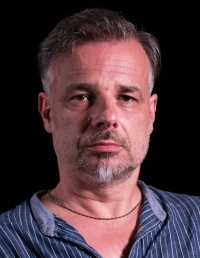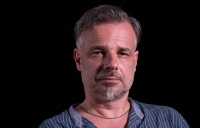Doc. Mgr. Jiří Černický
* 1966
-
“We were in this genuine working-class town, it was pretty dangerous for us. We had no support. Imagine coming to the workers as a ridiculous student and trying to convince them of something that is completely incomprehensible to them. They laughed at us, they did not see us as an equal and relevant partner to them. It often happened that they drove us out, shouting that if they ever saw me again, they would make sure I was kicked out of school. It was tough in the reproduction workshops, the boss knew my mum and my dad and intervened. Mum was freaking out. It wasn’t clear whether the revolution was going to change something.
It was dangerous and it took us a really long time to stop being so nervous. I walked around town with Libor Benda, he was a good kid. But we were scared of the revenge. We felt really lonely, the majority was against us. People kept lecturing us, we’d get somewhere and they took us for a fool. Being a student and coming to Armaturka, it was like in the mines. To them we were not representatives of a movement. We were idiots. They didn’t care about the revolution. They were not capable of talking about those social changes, they didn’t take it like that. And if a change, then a hateful one. To them we were undesirable elements, not hope. They told us: ‘You are just figures of fun, not the hopes of democracy; we’re happy to have a job so that we can make a living, so leave us alone.’”
-
“I had this idea, I liked Russian revolutionary avant-garde and the communists of the 1917 revolution had these strategies on how to connect with the working class. One of these strategies that impressed me was ‘Okna Rosta’ (Rosta windows), made by Trotsky and Mayakovsky. They travelled all over Russia, they had theatres, exhibitions, posters, painted carriages. And I thought: What an ethos, wow, we could really stun people from Ústí with this. So we were thinking about the ways we could use strategies of the 1917 Russian Revolution to get people interested in the Velvet Revolution. The Všebořice projects were being torn down, they did it by throwing these huge white tarps over the buildings and then letting it explode, so there wouldn’t be dust. The whole building collapses and is all hidden under the tarp. We drove around the buildings and tore down the white tarps. In the gym we unfolded the gigantic tarp and wrote Free Elections on it. We hung it up on the Mariánská skála rock that is in the middle of Ústí and overlooks the Elbe river. In the morning, it read – Free Elections. We had to convince the PE teachers, there were some climbers among them. They hung the tarp on the Mariánská skála rock and people woke up the next morning and it said – Free Elections.”
-
“And we had the projects near Střížák. That was an interesting hill, which is part of the whole magic. When you climbed over the hill, you found the biggest dump in the world which the Americans disposed of after the revolution. Today it’s this huge hill. For me, as a child, it was the most interesting place in the world because you could find these carpet tapes for hockey sticks there. We went there for the carpet tapes. Apart from that, you could find products of Chemofarma and Setuza there, all this sh*t, the chemical waste from factories. Chemical waste was not disposed of like it is done today but it was poured into these green ponds. A red pond, a green pond, that was the caustic on the surface of it. When you walked in it in rubber boots, it ate the boots, the rubber. There was quicklime, a desert of it, all cracked. When you fell into it, it ate your snow boots. My mum had waited in line for those and then I came home and my snow boot had been eaten by the quicklime. There was a hospital in Ústí and on the dump we found human organs from surgeries and syringes full of blood. I took those home and washed them in the basin. My mum was a dental technician, like I’ve said before. When she saw me washing out syringes in the basin, I got a thrashing.”
-
Full recordings
-
Praha, 27.06.2019
(audio)
duration: 01:56:45
Full recordings are available only for logged users.
In 1989 I realized that there is always time for a change
Jiří Černický was born August 1, 1966 in Ústí nad Labem. He spent his childhood in the Všebořice district, polluted with emissions and industrial toxins. He has two siblings: a brother and a sister. His mother worked as a dentist and his father was a builder. In primary school Jiří started redrawing comic books. In 1982 he commenced his studies at a secondary school of applied arts in Jablonec nad Nisou. He graduated in 1986 and was accepted to a teacher training college in Ústí nad Labem where he then studies arts and Russian language. He participated in the Velvet Revolution by creating posters and flyers that reflected his artistic skills. In 1990 he left school and started studying at the Academy of Arts, Architecture & Design in Prague. He was there until 1993, the he graduated from the Academy of Fine Arts in Prague. He pursued fine arts and multimedia art. In 1994 he travelled to Africa with his project ‘Tears of the World’, focused on the so-called mental health charity. In 1996 he received the Soros Award and in 1998 the Jindřich Chalupecký Award. He was the finalist of the Alice Francis Award in 2012. He became a senior lecturer at the Faculty of Arts and Design, Jan Evangelista Purkyně University in Ústí nad Labem in 2015. In 2019 he lived in Prague.

